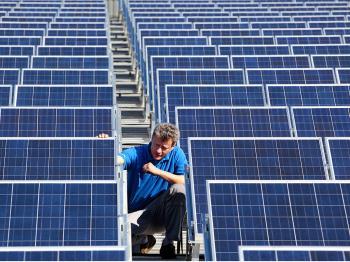Living green is challenging for adults because society and our social infrastructure are still built on the foundation laid by the Industrial Revolution. To break away, a new infrastructure needs to be built—one that allows living green to be the natural, easier, and a more convenient way to live.
One way of achieving this task is to educate the younger generation.
If we exclude nights, weekends, holidays, and summers, our nation’s children spend the better part of their waking hours at school for at least six months of the year. If we teach and model green behaviors and if we put things in place for them to be able to carry out these actions, then when they become the leaders of commerce and government, theoretically everything else will follow suit.
Many schools around the United States have realized this and have set up new learning environments for students—ones that are environmentally friendly as well as equitable in terms of the quality of education they provide.
One of the principal goals that schools have established in this regard is to reduce their carbon footprints.
The Green Schools Alliance based in New York City is one such organization that has taken the initiative to get schools around the nation to come aboard and take the initiative to create local school policies that will foster this commitment. So far, the Green Schools Alliance has over 175 schools in 30 states, the District of Columbia, the Virgin Islands, and also in Honduras and Russia.
Schools participating in the alliance make the promise to reduce their carbon footprints. There are several ways they go about doing this.
Some schools, like the Discovery Charter School in Tracy, California, and a certain Microsoft School of the Future in Pittsburgh, Penn., have gone almost completely paperless.
Other school districts are constructing their new schools to be more energy efficient by installing energy-efficient lighting, heating, and hot water systems. They are also making sure the electronic devices they buy are low-power output devices or that they carry the Energy Star certification.
At the same time, they are taking many steps to reduce wasteful habits. For example, schools are reducing water consumption; generating less waste in the classroom, cafeteria, or offices; recycling all paper, plastic, metals, and glass; and furthermore passing these habits on to the students.
Many schools that would like to “go green” but aren’t sure where or how to begin can bring in outside organizations like Echalk or AwarenessIDEAS. These groups provide literature, training, or workshops for teachers and/or school officials to help them come up with a “green” plan.
Many people say that the future rides on our youth. With increasing numbers of schools taking the initiative to instill green practices and ideals in our youth, it may help to ensure a greener future.
One way of achieving this task is to educate the younger generation.
If we exclude nights, weekends, holidays, and summers, our nation’s children spend the better part of their waking hours at school for at least six months of the year. If we teach and model green behaviors and if we put things in place for them to be able to carry out these actions, then when they become the leaders of commerce and government, theoretically everything else will follow suit.
Many schools around the United States have realized this and have set up new learning environments for students—ones that are environmentally friendly as well as equitable in terms of the quality of education they provide.
One of the principal goals that schools have established in this regard is to reduce their carbon footprints.
The Green Schools Alliance based in New York City is one such organization that has taken the initiative to get schools around the nation to come aboard and take the initiative to create local school policies that will foster this commitment. So far, the Green Schools Alliance has over 175 schools in 30 states, the District of Columbia, the Virgin Islands, and also in Honduras and Russia.
Schools participating in the alliance make the promise to reduce their carbon footprints. There are several ways they go about doing this.
Some schools, like the Discovery Charter School in Tracy, California, and a certain Microsoft School of the Future in Pittsburgh, Penn., have gone almost completely paperless.
Other school districts are constructing their new schools to be more energy efficient by installing energy-efficient lighting, heating, and hot water systems. They are also making sure the electronic devices they buy are low-power output devices or that they carry the Energy Star certification.
At the same time, they are taking many steps to reduce wasteful habits. For example, schools are reducing water consumption; generating less waste in the classroom, cafeteria, or offices; recycling all paper, plastic, metals, and glass; and furthermore passing these habits on to the students.
Many schools that would like to “go green” but aren’t sure where or how to begin can bring in outside organizations like Echalk or AwarenessIDEAS. These groups provide literature, training, or workshops for teachers and/or school officials to help them come up with a “green” plan.
Many people say that the future rides on our youth. With increasing numbers of schools taking the initiative to instill green practices and ideals in our youth, it may help to ensure a greener future.


